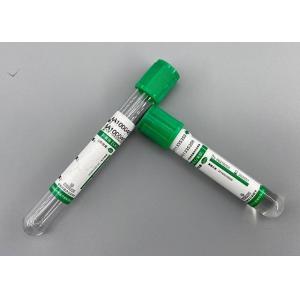
Add to Cart
Green blood collecting vessel heparin anticoagulant tube
Heparin is added to the blood collection tube. Heparin directly has the effect of antithrombin, which can prolong the clotting time of the specimen. Excessive heparin will cause the accumulation of white blood cells and cannot be used for white blood cell counting because it can make the blood slice stained and the background is light blue Therefore, it is not suitable for white blood cell classification.
Sample type: whole blood, plasma
Uses: Red blood cell fragility test, blood gas analysis, hematocrit test, erythrocyte sedimentation rate and general energy biochemical determination.
The disposable vacuum blood collection container consists of a test tube, a plug, a cap, a label, additives (if any) and additives (if any).
Used in conjunction with disposable intravenous needles for the collection, transportation and preservation of human venous blood.
Store in a dry, well-ventilated and clean room with no corrosive gas and relative humidity above 80%
1 according to different inspection requirements, choose the appropriate blood collection tube. In case of doubt, please contact the laboratory staff at any time.
2 The sample number must be pasted on the blood collection tube, which is consistent with the number on the inspection sheet. It should be pasted on the paper label of blood collection tube, not on the glass to prevent it from falling off.
3 When taking blood, patients should relax, keep the environment warm, prevent venous contracture, and wear tourniquet for too long (now some scholars think that tourniquet should not be used as much as possible). Observe whether blood collection is smooth, and do not pat the arm, otherwise it may cause local blood concentration or activate the coagulation system.
4 The recommended order of blood collection is anticoagulant-free tube (serum tube) → separation gel/coagulant tube → heparin /EDTA tube → coagulation vessel → sedimentation tube. The main reason is that the first tube often contains tissue fluid, which is easy to cause blood coagulation and is not suitable for blood coagulation measurement; Furthermore, the serum tube is prevented from being polluted by anticoagulant.
5 After the completion of blood collection, the blood samples shall be rolled up and classified according to different inspection categories (biochemistry, immunity, routine, coagulation and erythrocyte sedimentation rate). All blood samples shall not be mixed and rolled together to avoid confusion in operation.
6 The ratio of blood to anticoagulant must be accurate, and the amount of blood collected should meet the requirements.
7 After blood collection, gently reverse the test tube and mix it 8-10 times, but do not shake violently. After blood collection, the sample should be placed vertically



